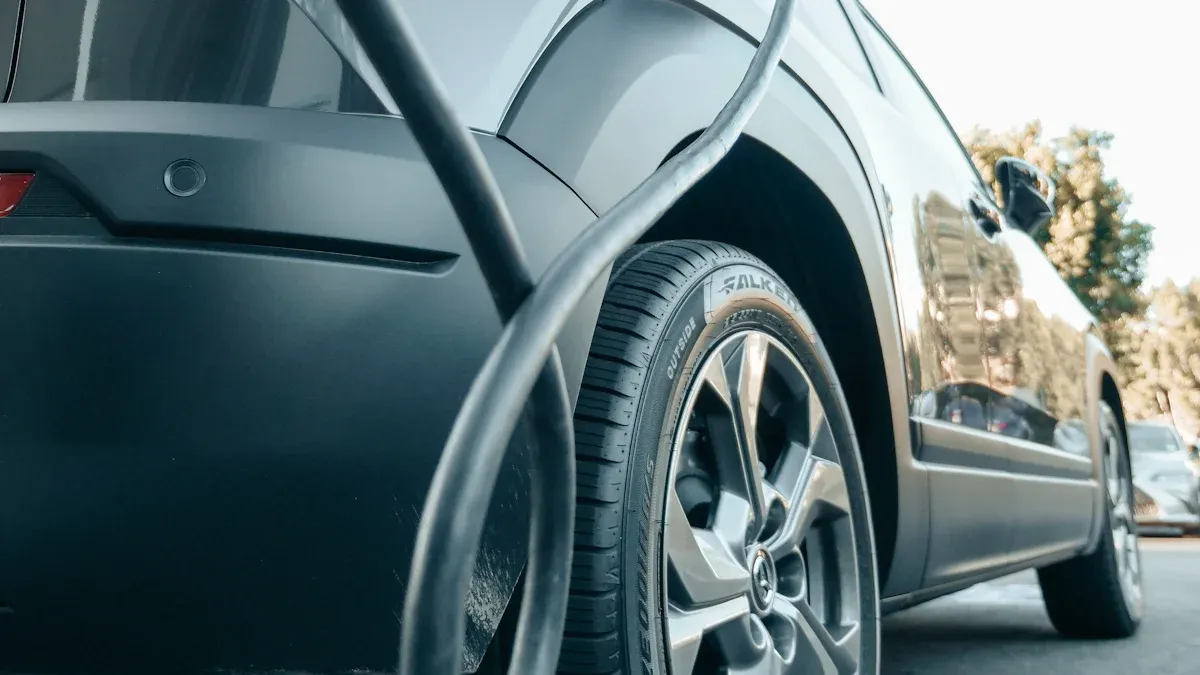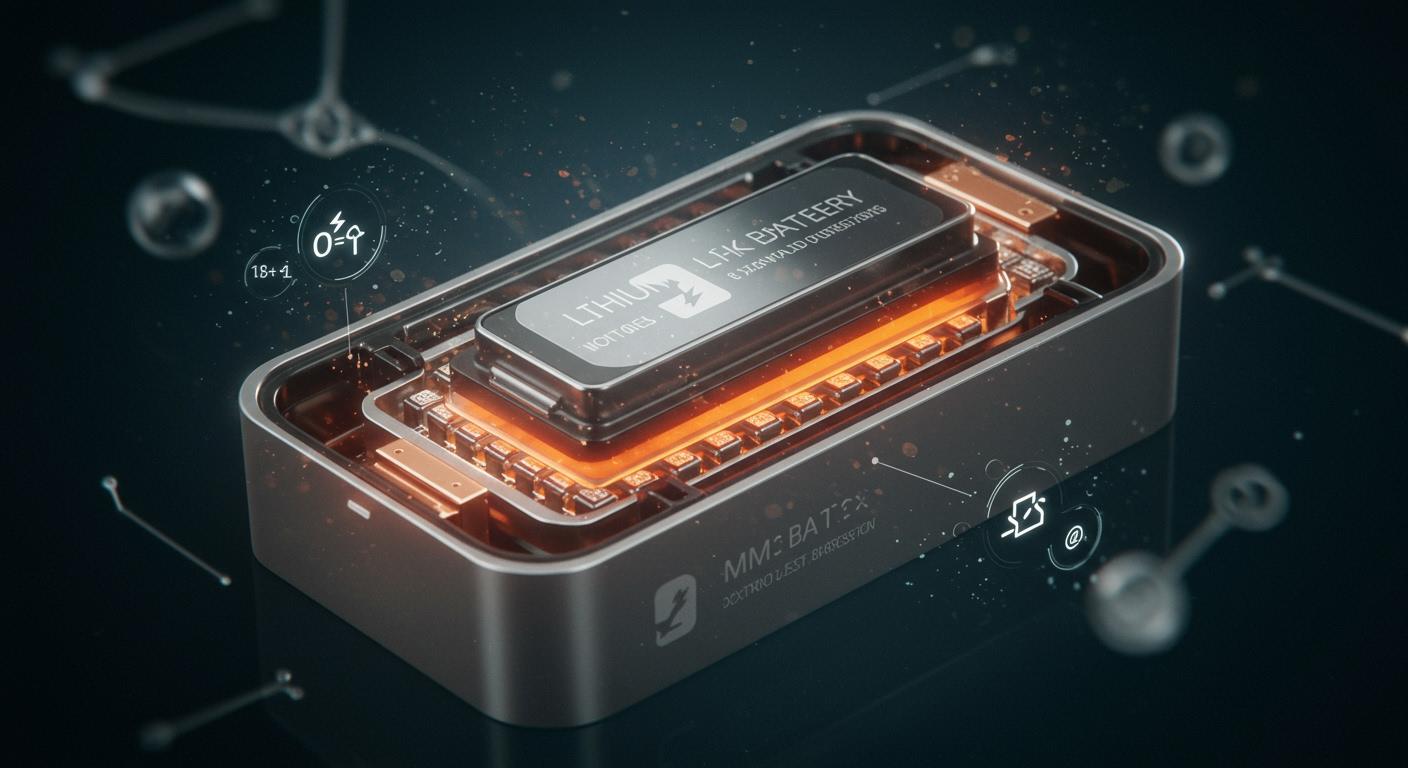New technique produces longer-lasting lithium batteries
You depend on your devices every day, so battery life matters. A new technique using a nano-coating helps create longer-lasting lithium batteries for your phone, laptop, or electric car. Recent studies show these batteries can last up to 2000-3000 cycles and remain useful for 15-20 years, which is a major improvement.
| Performance Parameter | Conventional Lithium-ion Batteries | New Long-Life Batteries | Improvement Percentage |
|---|---|---|---|
| Cycle Life (to 80% capacity) | 800-1000 cycles | 2000-3000 cycles | 150-200% increase |
| Calendar Life | 8-10 years | 15-20 years | 80-100% increase |
Key Takeaways
- Boron nitride nano-coating significantly extends lithium battery life, allowing for 2000-3000 charge cycles compared to 800-1000 cycles in traditional batteries.
- The new coating improves battery safety by suppressing dendrite growth, which can cause short circuits and overheating.
- Solid electrolytes stabilized by the nano-coating enhance battery performance, leading to faster charging and longer-lasting energy storage.
- Longer-lasting lithium batteries reduce electronic waste and costs, benefiting both consumers and industries by providing reliable power for devices and electric vehicles.
- Future advancements in battery technology promise even greater energy density and safety, paving the way for more sustainable energy solutions.
New technique for battery longevity

Boron nitride nano-coating
You may wonder how scientists make lithium batteries last longer. Columbia engineers have developed a new technique that uses a boron nitride nano-coating to protect and improve battery performance. This nano-coating covers the lithium metal anode, which is the part of the battery that stores and releases energy.
Boron nitride nanotubes (BNNTs) and hexagonal boron nitride (h-BN) play a key role in this process. Here are some important features of the boron nitride nano-coating:
- BNNTs have a hexagonal honeycomb structure, similar to carbon nanotubes, made from boron and nitrogen atoms.
- These nanotubes show strong mechanical properties and high thermal conductivity, which help manage heat inside the battery.
- The coating acts like a ceramic, giving chemical and thermal stability. This makes it a good separator in lithium batteries.
- BNNTs improve how lithium ions move because they interact well with the battery’s electrolyte.
- Hexagonal boron nitride separators help keep the lithium metal anode stable. They stop harmful reactions and prevent the loss of important battery materials.
The boron nitride nano-coating does more than just cover the anode. It interacts with lithium at the molecular level, creating a safer and more efficient battery. The table below shows how this interaction works:
| Interaction Type | Description |
|---|---|
| Lewis Acid-Base Interaction | Boron sites in hBN attract certain anions, which helps lithium ions move faster and more efficiently. |
| Ion Transport | Tiny defects in hBN let lithium ions pass through but block unwanted materials, keeping the battery safe. |
| Mechanical Strength | The strong hBN layer resists damage from lithium dendrites, which can cause battery failure. |
You also benefit from the electronegative groups in the coating. These groups help form a stable layer on the anode, which allows lithium ions to move quickly and keeps the battery working well for a long time.
Stabilizing solid electrolytes
Solid electrolytes are important for next-generation energy storage because they make batteries safer and more reliable. The boron nitride nano-coating helps stabilize these electrolytes in several ways.
Researchers found that adding polyelectrolytes to boron nitride nanospheres (BNNSs) changes how they behave in the battery. When you use the right amount of polyelectrolyte, the BNNSs become more stable. This happens because the polyelectrolyte chains create both electrical and physical barriers, which stop the particles from clumping together. As a result, the battery’s solid electrolyte stays evenly spread out and works better over time.
You can see the difference this makes in battery life. In experiments, batteries without a protective layer lost almost half their capacity after just 100 cycles. When scientists added a buffer layer, the batteries kept 76% of their capacity after 100 cycles. Some batteries with this technology lasted over 1000 cycles, showing a big improvement in how long they can work.
Tip: A stable solid electrolyte means your battery will last longer, charge faster, and stay safer, even after many uses.
This new technique marks a big step forward in battery technology. It helps create batteries that last longer, perform better, and support the growing demand for safer, more powerful devices.
How longer-lasting lithium batteries work
Lithium metal vs. graphite anodes
You might wonder why lithium metal anodes matter for energy storage. Traditional batteries use graphite anodes, but lithium metal anodes offer much higher capacity. Take a look at this table to see the difference:
| Anode Type | Theoretical Capacity (mAh/g) |
|---|---|
| Lithium Metal | 3860 |
| Graphite | 372 |
Lithium metal anodes can store more energy, which means your devices can run longer between charges. You also get better performance because lithium metal avoids fast-charging bottlenecks. This makes it possible to charge your phone or electric car faster and more safely. Lithium metal can even form directly inside the battery, which helps with advanced electrode engineering.
Lithium metal anodes:
- Increase energy density
- Allow for faster charging
- Support in-situ formation for better battery design
Enhanced stability and performance
You benefit from longer-lasting lithium batteries because of the nano-coating on the anode. This coating helps stabilize solid electrolytes and improves battery life. The boron nitride layer stops harmful reactions and keeps the battery’s structure strong. It also prevents the growth of dangerous dendrites, which can cause short circuits.
Here is how the nano-coating improves safety and performance:
| Mechanism | Description |
|---|---|
| Enhancing Hardness | Makes the separator stronger and more resistant to dendrite penetration. |
| Enhancing Electrolyte Wettability | Improves how the electrolyte interacts with the separator, helping ions move smoothly. |
| Regulating Li+ Flux | Controls lithium ion flow for even charging and discharging. |
| Uniforming Nucleation of Li+ | Promotes even lithium growth, reducing the risk of short circuits. |
You also see better results in battery tests. For example, batteries with the nano-coating keep 96.5% of their capacity after 500 cycles. They can deliver high power, reaching 105 mAh g−1 at fast charge rates. These improvements come from sophisticated electrolyte formulations and the ability to stabilize solid electrolytes, which are key for improving safety and energy density.
Note: With these advances, you get batteries that last longer, perform better, and keep your devices safer.
Battery longevity technology vs. conventional methods
Lifespan and safety improvements
You see a clear difference when you compare longer-lasting lithium batteries to traditional lithium-ion batteries. The new battery longevity technology lets you use your devices for 2000-3000 complete charge cycles. Conventional batteries usually degrade after 800-1000 cycles. This means you get a lifespan increase of about 100% to 275%. You spend less time worrying about battery life and more time using your devices.
- The new technology supports up to 3000 cycles.
- Traditional batteries last only 800-1000 cycles.
- You get up to 2.75 times more use from each battery.
Safety also improves with the new nano-coating. Boron nitride nanosheets boost thermal conductivity and create a protective layer on the lithium metal anode. This layer suppresses dendrite growth, which often causes short circuits in older batteries. You benefit from a safer battery that resists overheating and internal damage.
| Metric | BNNS-Enhanced Batteries | Traditional Lithium-Ion Batteries |
|---|---|---|
| Battery Cycling Stability | Over 40% improvement | Baseline |
| Thermal Runaway Onset Temperature | Increased by 35-45°C | Baseline |
You also see major safety gains:
- Discharge current drops 11-fold after overheating.
- Thermal-induced short circuits are delayed by up to 293 minutes.
- Dendrite growth is suppressed, so batteries retain 95% capacity over 3000 hours.
Research findings and real-world results
Lab tests and industry trials show that longer-lasting lithium batteries outperform conventional models. You notice a 150% reduction in electrolyte decomposition, which means the battery stays stable and efficient. Cyclic stability improves by 13% after 300 cycles, so you get more reliable energy storage.
| Metric | Improvement |
|---|---|
| Electrolyte Decomposition | 150% reduction |
| Cyclic Stability (300 cycles) | 13% improvement |
Common failure modes like mechanical, electrical, and thermal breakdowns are less likely with the new technology. Protective devices and improved cooling strategies help stabilize solid electrolytes and keep your battery safe.
Tip: Choosing batteries with advanced nano-coating gives you longer life, better safety, and stronger performance for all your devices.
Benefits and future of longer-lasting lithium batteries

Consumer and industry impact
You experience major changes in your daily life as longer-lasting lithium batteries become more common. Electric vehicles benefit the most. Manufacturers use new coatings and high silicon content to increase battery life and energy density. The table below shows how these innovations affect electric vehicles:
| Innovation | Description | Impact |
|---|---|---|
| HOS-PFM Coating | Conductive polymer coating for lithium-ion batteries | Increases battery life from 10 to 15 years, faster charging |
| High Silicon Content | Electrodes with up to 80% silicon | Boosts energy density by 30%, lowers costs |
| Manufacturing Scalability | Plans for mass production | Makes batteries affordable for entry-level electric vehicles |
You see improvements in consumer electronics, too. Devices last longer and charge faster. Manufacturers focus on new electrode materials and advanced electrolytes. You get more reliable power for phones, laptops, and tablets. These changes support the portable device revolution.
Environmental and economic effects
Longer-lasting lithium batteries help renewable energy systems and energy storage solutions. You notice lower costs and better efficiency. Since 2010, battery energy storage costs dropped by 93%. Solar and wind power now provide electricity more reliably. You can store energy during off-peak hours and use it when needed, reducing your reliance on the grid.
- Lithium solar batteries improve solar system efficiency with 90-95% round-trip efficiency.
- Lifespans reach up to 20 years, reducing waste compared to lead-acid batteries.
- Charging efficiencies exceed 95%, lowering carbon emissions.
- Fewer replacements mean less electronic waste and lower costs for you and industries.
You save money because lithium batteries last up to five times longer than lead-acid batteries. They provide 2,000 to 4,000 charge cycles, so you replace them less often. Fast charging minimizes downtime. Industries reduce operational costs and energy consumption, making these batteries a smart financial choice.
Future directions
You can expect more breakthroughs in next-generation energy storage. Researchers work to stabilize solid electrolytes and develop new materials. Projects in Europe focus on fourth-generation lithium-ion batteries with solid electrolytes and silicon anodes. These batteries could double energy density and improve safety.
- Scientists develop electrolytes for extreme temperatures, including liquefied gas electrolytes.
- New strategies enhance the durability of lithium-rich layered oxide materials, keeping batteries stable for hundreds of cycles.
- Polyimides and boron nitride coatings show promise for improving battery longevity and safety.
You may face some barriers, such as high costs and complex coating processes. Manufacturers work to overcome these challenges and make longer-lasting lithium batteries available for electric vehicles, renewable energy systems, and consumer electronics. You will see more reliable, efficient, and sustainable energy storage in the future.
You gain several advantages from boron nitride nano-coating in lithium batteries. The table below highlights key benefits:
| Advantage | Description |
|---|---|
| Enhanced Chemical Stability | Improves battery lifespan and reliability. |
| Improved Safety | Reduces risks from overheating and short circuits. |
| Versatility in Applications | Works in cars, electronics, and energy storage. |
| Support for Renewable Energy | Boosts efficiency in solar and wind systems. |
You help drive sustainability by choosing batteries with advanced coatings. Experts predict strong market growth, with a 10.5% annual increase through 2034. Ongoing innovation will shape cleaner energy and safer technology for your future.
-

 May.2025.11.24Ternary Lithium Battery vs Lithium-ion: Complete Comparison Guide (2025 Edition)Learn More
May.2025.11.24Ternary Lithium Battery vs Lithium-ion: Complete Comparison Guide (2025 Edition)Learn More -

 May.2025.11.214S2P 18650 14.8V Battery: Complete Technical Guide, Specs, Applications & SafetyLearn More
May.2025.11.214S2P 18650 14.8V Battery: Complete Technical Guide, Specs, Applications & SafetyLearn More -

 May.2025.11.18PCM vs BMS in Lithium Batteries: What’s the Difference and Which One Do You Need?Learn More
May.2025.11.18PCM vs BMS in Lithium Batteries: What’s the Difference and Which One Do You Need?Learn More -

 May.2025.11.17Custom Li-ion Battery Design for Medical Devices (2025 Comprehensive Guide)Learn More
May.2025.11.17Custom Li-ion Battery Design for Medical Devices (2025 Comprehensive Guide)Learn More -

 May.2025.11.17The Future of Lithium-Ion Batteries: Innovation, Sustainability, and Global Market TrendsLearn More
May.2025.11.17The Future of Lithium-Ion Batteries: Innovation, Sustainability, and Global Market TrendsLearn More
















